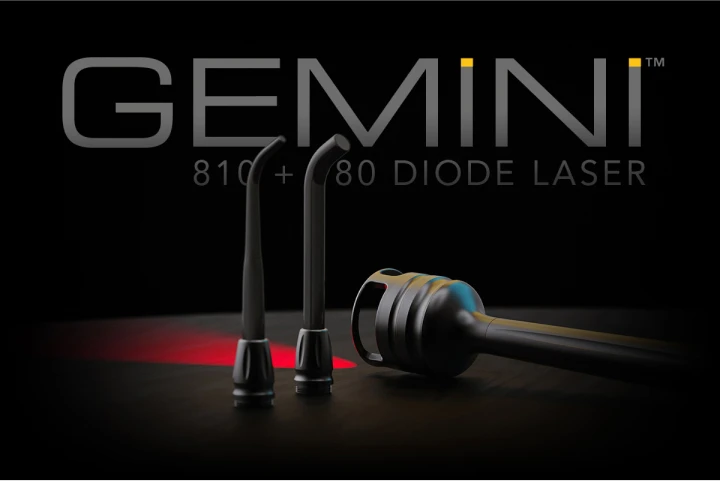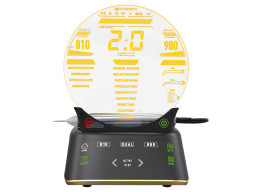What Is Photobiomodulation?
Tuesday, March 18, 2025
As a dental professional, you’ve most likely heard of photobiomodulation therapy (PBM). As the industry leader in soft tissue dental lasers, Ultradent’s Gemini™ and Gemini EVO™ lasers both feature photobiomodulation therapy options. Photobiomodulation (PBM) is used to improve cell metabolism, local blood circulation, and modulate inflammation to provide temporary pain relief at the treatment site and stimulate tissue healing.
Photobiomodulation (PBM) is a noninvasive and nonthermal process where light energy of a certain wavelength, intensity, and duration (therapeutic window) is absorbed at a cellular level, eliciting photophysical and photochemical events that improve cell metabolism, enzymes activity, local bloodcirculation, and tissue oxygenation, resulting in beneficial therapeutic outcomes including but not limited to the alleviation of pain or inflammation, and promotion of wound healing and tissue regeneration.
Reference: Anders JJ, Lanzafame RJ, Arany PR. Low-level light/laser therapy versus photobiomodulation therapy. Photomed Laser Surg. 2015 Apr;33(4):183–184. doi: 10.1089/pho.2015.9848.

The Science Behind PBM Therapy
So, how does photobiomodulation work? Does PBM therapy work? The primary mechanism of action is the absorption of light by cytochrome c oxidase within mitochondria, causing increased ATP generation, increased reactive oxygen species (ROS), and nitric oxide generation.1
- Increased ATP provides more energy for cellular repair
- More nitric oxide expands blood vessels, increases blood flow, and decreases inflammation
In other words, light at the proper wavelength, intensity, and duration (therapeutic window) being absorbed in stressed cellular situations or inflammatory cells (low in ATP, high in oxidative stress) leads to more ATP, less oxidative stress, faster healing, and optimized mitochondria function.
Yes, PBM therapy has been shown to work. Patients frequently report temporary pain relief, faster healing, and other benefits from areas treated with PBM therapy after dental procedures. The most important variable in PBM is treatment dose. The clinical effects of the laser—such as wound healing, muscle relaxation, and temporary pain relief—are all sensitive to different irradiances.
These stimulatory effects are governed by the Arndt-Schultz Law2, which says that weak stimuli will increase physiological processes and strong stimuli will stop physiological processes. This therapeutic window is the intended target for PBMT in the dental industry.
How Photobiomodulation Therapy Is Improving Laser Dentistry
We all know someone who has a fear of the dental chair, due to a negative experience, the noise of a dental drill, or something else commonplace to a dental office. Modern laser dentistry has already changed the game for dentists all over the world, but now that PBM therapy is making advancements, dental lasers have even more to offer.
“Gemini EVO cuts much smoother than any other diode laser I have used. I have seen less necrosis around the surrounding tissues, which creates faster healing. The photobiomodulation portion is awesome, easy to use, and I love the intraoral tips.”
— Dr. Ed Kusek
It doesn’t take a lot to understand how this amazing treatment option can help a dental office’s bottom line. Many dental professionals report more billable treatment options as well as higher rates of elective treatments with PBM. While this is excellent news for the dental industry across the globe, the real benefits are to the patients. As photobiomodulation therapy is done with a laser such as the Gemini EVO diode laser from Ultradent, the treatment is typically gentle and efficient. The benefits of PBM to your dental patients include:
- Temporary pain relief
- Improved local blood circulation
- Temporary relaxation of muscle
- Moderation of inflammation
- Acceleration of soft and hard tissue healing
A dental patient’s treatment dose and duration will be highly determined by the status of their injury. Many dental patients suffer from acute and chronic oral pain, both of which can be temporarily alleviated with PBM.
Studies have shown that PBM for acute pain reduction is highly compared to standard nonsteroidal anti-inflammatory drugs (NSAIDs), but with a better risk-benefit profile.3By stimulating epithelial, fibroblasts, and osteoblasts functions, PBM leads to faster healing and better quality of tissues formed in oral mucosa and bone in response to different injuries.4–5
Examples of possible use cases for PBMT include:
- TMD
- Dentin hypersensitivity
- Neuropathic pains (trigeminal neuralgia)
- Oral mucositis
- Traumatic and aphthous lesions
- Herpetic lesions
- Oral lichen planus
- Implant healing
- Orthodontic tooth movement
- Socket healing
- Alveolar osteitis
- Bone exposures—bone necrosis
- Surgical post-operative third molar extraction and orthognathic
Marsilio et. al. conducted a study demonstrating that PBMT treatment of dentin hypersensitivity in two patient groups was effective for 86% to 88% of the participants.6 Another study compared PBM to topical fluoride varnish for dentin hypersensitivity treatment, showing that while 27% of the fluoride group showed signs of pain relief, 86% of the laser irradiation group indicated they had less pain.7
Pain relief is also significant for dental patients. In a clinical study of 74 patients complaining of TMJ pain, 64% were pain-free or had improved comfort after 12 PBMT sessions over a six-week period.8
PBM reduced the pain and the inconvenience of eating, drinking, and brushing teeth for patients with recurrent aphthous stomatis compared with placebo.9
Gemini EVO Dental Laser
If your practice doesn’t already have a dental laser, consider the benefits one might add to your daily routine at the office. Whether you’re using laser dentistry to build lasting relationships with your patients through add-on treatments or billable therapy options, your patients will greatly benefit from the effects of photobiomodulation.
In the United States, the FDA has cleared photobiomodulation for pain relief. This means topical heating for the purpose of elevating tissue temperature for temporary relief of minor muscle and joint pain and stiffness, minor arthritis pain, muscle spasm, minor sprains and strains, minor muscular back pain, temporary increase in local blood circulation, and temporary muscle relaxation.
Indications for Use
Studies have shown that PBMT for acute pain reduction is highly compared to standard nonsteroidal anti-inflammatory drugs (NSAIDs), but with a better risk-benefit profile.1 By stimulating fibroblasts and osteoblasts, which produce bone and soft tissue, healing is also accelerated.
A dental patient’s treatment dose and duration will be highly determined by the status of their injury. Many dental patients suffer from acute and chronic oral pain, both of which can be temporarily alleviated with PBMT. While acute pain can be effectively treated with frequent doses of laser therapy, chronic pain is often best treated through lower doses over a longer period of time.
- TMJ/TMD
- Dentin hypersensitivity
- Implant healing
- Orthodontic tooth movement
- Oral mucositis
Marsilio et. al. conducted a study demonstrating that PBMT treatment of dentin hypersensitivity in two patient groups was effective for 86% to 88% of the participants.2 Another study compared PBMT to topical fluoride varnish for dentin hypersensitivity treatment, showing that while 27% of the fluoride group showed signs of pain relief, 86% of the laser irradiation group indicated they had less pain.3
Pain relief is also significant for dental patients. In a clinical study of 74 patients complaining of TMJ pain, 64% were pain-free or had improved comfort after 12 PBMT sessions over a six-week period.4
Gemini EVO Dental Laser
If your practice doesn’t already have a dental laser, consider the benefits one might add to your daily routine at the office. Whether you’re using laser dentistry to build lasting relationships with your patients through add-on treatments or billable therapy options, your patients will greatly benefit from the effects of photobiomodulation.

Dental lasers such as the Gemini and Gemini EVO diode lasers were built with PBM in mind. The Gemini EVO laser comes with three PBM therapy adapters so that you can take full advantage of your new dental laser. The 3 mm and 7 mm intraoral PBM adapter tips are ideal for targeting small treatment areas such as around the teeth (dentin hypersensitivity) or localized spot in mucosa or bone such as for ulcerative lesions of different origins (aphthous, herpetic, auto-immune or mucositis), socket healing, treatment of alveolar osteitis (dry socket) and bone exposures (bone necrosis). The 25mm extraoral PBM adapter is designed for efficient treatment of large spots such as orofacial pain like TMD (muscle and TMJ area) and neuropathic pains (trigeminal neuralgia) and also for oral mucositis, post-operative of different surgical procedures such as third molar extraction and orthognathic. The laser makes PBMTs easy by presetting the proper energy density for each PBM adapter. There’s even a PBM treatment calculator on the dashboard to help dental professionals determine the proper treatment time.
At Ultradent, our goal is to make laser dentistry more accessible to every practice and, by extension, people in every corner of the globe. If the dental industry can offer faster, more effective treatment with minimal pain, we'll improve everyone’s lives along the way. PBM is an evolving technology, and with it, dental professionals can reduce pain, stimulate wound healing, and modulate inflammatory responses. All dental professionals, including dentists and dental specialists, should look further into PBMT and how this incredible technology can enhance their clinical treatments and outcomes.
- Hamblin MR. Mechanisms and Mitochondrial Redox Signaling in Photobiomodulation. Photochem Photobiol. 2018 Mar;94(2):199–212.
- Chung H, Dai T, Sharma SK, Huang YY, Carroll JD, Hamblin MR.The nuts and bolts of low-level laser (light) therapy. Ann Biomed Eng. 2012 Feb;40(2):516–533.
- Pesevska S, Nakova M, Ivanovski K, Angelov N, Kesic L, Obradovic R, Mindova S, Nares S. Dentinal hypersensitivity following scaling and root planingL Comparison of low-level laser and topical fluoride treatment. Lasers Med Sci. Epub 2009 Jun 1. DOI 10.1007/s10103-009-0685-0.
- Mármora BC, Brochado FT, Schmidt TR, et al. Defocused high-power diode laser accelerates skin repair in a murine model through REDOX state modulation and reepithelization and collagen deposition stimulation. J Photochem Photobiol B. 2021 Dec;225:112332
- Wagner VP, Meurer L, Martins MA, et al. Influence of different energy densities of laser phototherapy on oral wound healing. J Biomed Opt. 2013 Dec;18(12):128002
- Marsilio AL, Rodrigues JR, Borges AB. Effect of the clinical application of the GaA1As laser in the treatment of dental hypersensitivity. J Clin Laser Med Surg 2003;21(5):291–296.
- Carvalho CM, de Lacerda JA, Dos Santos Neto FP, Cangussu MCT, Marques AMC, Pinheiro ALB. Wavelength effect in temporomandibular joint pain: A clinical experience. Lasers Med Sci. Epub 2009 Jun 30. DOI 10.1007/s10103-009-0695-y.
- de Freitas LF, Hamblin MR. Proposed Mechanisms of Photobiomodulation or Low-Level Light Therapy. IEEE J Sel Top Quantum Electron. 2016;22(3):7000417. doi:10.1109/JSTQE.2016.2561201.
- Albrektson M, Hedström L, Bergh H. Recurrent aphthous stomatitis and pain management with low-level laser therapy: a randomized controlled trial. Oral Surg Oral Med Oral Pathol Oral Radiol. 2014 May;117(5):590-594

